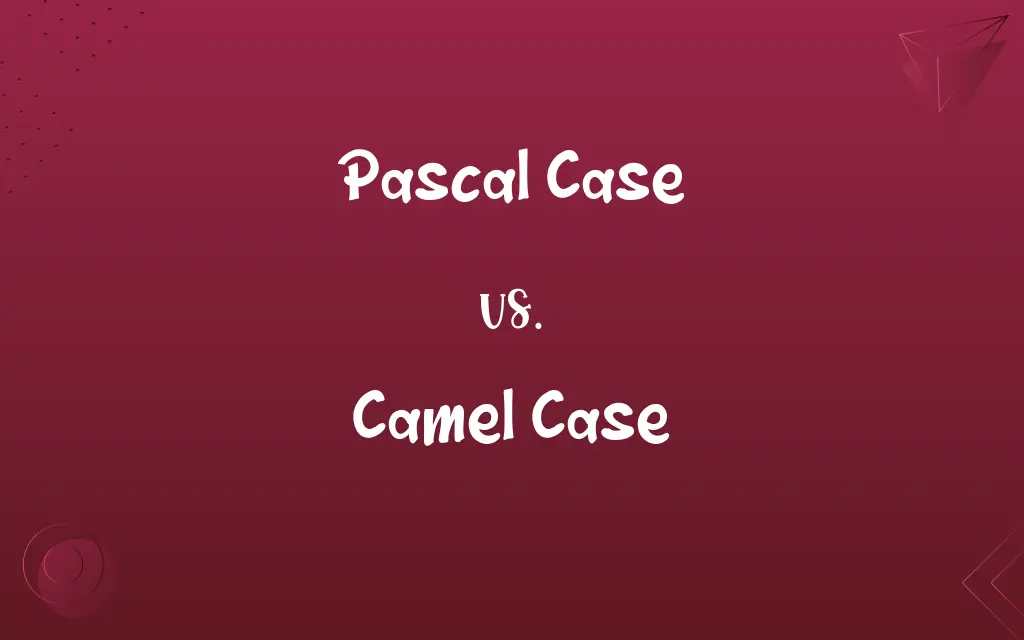Pascal Case vs. Camel Case: Know the Difference

By Shumaila Saeed || Published on February 22, 2024
Pascal Case capitalizes the first letter of each word (e.g., PascalCase); Camel Case capitalizes the first letter of each word except the first (e.g., camelCase).

Key Differences
Pascal Case is a naming convention in which each word within a compound word begins with a capital letter, with no intervening spaces or punctuation. Camel Case, similarly, is a compound word format where the first word starts with a lowercase letter and subsequent words start with uppercase letters.
Shumaila Saeed
Feb 22, 2024
In Pascal Case, every word, including the first, is capitalized, making it common in certain programming contexts like class names in C# and Java. Camel Case, on the other hand, begins with a lowercase letter, making it a frequent choice for variable names in programming languages like JavaScript and Python.
Shumaila Saeed
Feb 22, 2024
Pascal Case provides a clear distinction at the start of each word, which can enhance readability in certain cases, such as in defining object-oriented programming constructs. Camel Case, while also enhancing readability, does so with a more subtle approach, emphasizing the start of new words from the second word onward.
Shumaila Saeed
Feb 22, 2024
The use of Pascal Case is often dictated by language-specific conventions or coding standards, especially in statically typed languages. Conversely, Camel Case is widely adopted in both statically and dynamically typed languages, often seen in scripting languages and APIs.
Shumaila Saeed
Feb 22, 2024
Pascal Case and Camel Case both improve the clarity and comprehension of compound words in code, but their usage varies depending on the programming context, with Pascal Case often signaling a more formal or structural element like a class or interface, while Camel Case typically indicates variables or functions.
Shumaila Saeed
Feb 22, 2024
ADVERTISEMENT
Comparison Chart
Subsequent Words
Each word starts with uppercase
Each word starts with uppercase
Shumaila Saeed
Feb 22, 2024
Programming Context
Often in statically typed languages
Common in both static and dynamic languages
Shumaila Saeed
Feb 22, 2024
ADVERTISEMENT
Pascal Case and Camel Case Definitions
Pascal Case
Pascal Case is commonly used in programming for class names.
MyApplication follows the Pascal Case convention.
Shumaila Saeed
Jan 24, 2024
Camel Case
Camel Case is commonly used for variable and method names in programming.
CalculateTotal follows Camel Case naming.
Shumaila Saeed
Jan 24, 2024
Pascal Case
Each new word in Pascal Case begins with a capital letter.
DataEntryForm is written in Pascal Case.
Shumaila Saeed
Jan 24, 2024
Camel Case
The second and subsequent words in Camel Case begin with uppercase letters.
FindUserById is written in Camel Case.
Shumaila Saeed
Jan 24, 2024
Pascal Case
Pascal Case ensures each word is equally emphasized.
ProductList demonstrates Pascal Case usage.
Shumaila Saeed
Jan 24, 2024
ADVERTISEMENT
Camel Case
Camel Case starts with a lowercase letter and capitalizes subsequent words.
MyVariable is an example of Camel Case.
Shumaila Saeed
Jan 24, 2024
Pascal Case
Pascal Case capitalizes the first letter of each word in a compound word.
CustomerProfile is an example of Pascal Case.
Shumaila Saeed
Jan 24, 2024
Camel Case
Camel Case blends words together with the initial word in lowercase.
ReadFileContents uses the Camel Case style.
Shumaila Saeed
Jan 24, 2024
Pascal Case
In Pascal Case, no spaces or punctuation separate the words.
FinancialReportGenerator uses Pascal Case.
Shumaila Saeed
Jan 24, 2024
Camel Case
In Camel Case, words are joined without spaces, starting with a lowercase letter.
TotalItemCount demonstrates Camel Case.
Shumaila Saeed
Jan 24, 2024
Repeatedly Asked Queries
When is Pascal Case typically used?
Pascal Case is often used for class and method names in programming.
Shumaila Saeed
Feb 22, 2024
What is Pascal Case?
Pascal Case is a naming convention where each word in a compound word begins with a capital letter.
Shumaila Saeed
Feb 22, 2024
When is Camel Case commonly applied?
Camel Case is frequently used for variable and function names in programming.
Shumaila Saeed
Feb 22, 2024
Is Camel Case suitable for class names?
While Camel Case can be used for class names, Pascal Case is more commonly used for this purpose.
Shumaila Saeed
Feb 22, 2024
Does Pascal Case include spaces?
No, Pascal Case does not include spaces or punctuation between words.
Shumaila Saeed
Feb 22, 2024
Does Camel Case include any punctuation?
Camel Case also omits spaces and punctuation, blending words together.
Shumaila Saeed
Feb 22, 2024
Is Camel Case more common in any specific programming languages?
Camel Case is widespread across many programming languages, especially in JavaScript and Python.
Shumaila Saeed
Feb 22, 2024
Are there exceptions to using Pascal Case in programming?
Usage may vary based on specific coding guidelines or language conventions.
Shumaila Saeed
Feb 22, 2024
What is Camel Case?
Camel Case is a style where the first word starts with a lowercase letter and subsequent words start with uppercase letters.
Shumaila Saeed
Feb 22, 2024
Can Pascal Case improve code readability?
Yes, Pascal Case can enhance readability by clearly demarcating each word.
Shumaila Saeed
Feb 22, 2024
Can both Pascal Case and Camel Case be used in the same project?
Yes, they can coexist, often with specific roles like classes (Pascal Case) and variables (Camel Case).
Shumaila Saeed
Feb 22, 2024
How does Camel Case affect sorting of variables alphabetically?
Camel Case can affect sorting order, as it differentiates between upper and lower case.
Shumaila Saeed
Feb 22, 2024
Is Pascal Case case-sensitive?
Yes, the capitalization of each word in Pascal Case is significant.
Shumaila Saeed
Feb 22, 2024
Can Pascal Case be used for variable names?
While possible, Camel Case is generally preferred for variable names.
Shumaila Saeed
Feb 22, 2024
How does Camel Case handle acronyms?
Acronyms in Camel Case typically follow the same rules, starting with lowercase for the first word.
Shumaila Saeed
Feb 22, 2024
Is Pascal Case used outside of programming?
It's mostly used in programming, but can be applied in other naming contexts.
Shumaila Saeed
Feb 22, 2024
Are there any best practices for using Pascal Case or Camel Case?
Best practices include consistency and adhering to language-specific guidelines or team standards.
Shumaila Saeed
Feb 22, 2024
Can Camel Case help in avoiding naming conflicts in code?
Yes, by providing a consistent naming convention, Camel Case can reduce conflicts.
Shumaila Saeed
Feb 22, 2024
Are there any drawbacks to using Camel Case?
One potential drawback is that initial lowercase may reduce visibility of the first word.
Shumaila Saeed
Feb 22, 2024
Is Pascal Case preferred in any specific programming paradigms?
Pascal Case is often preferred in object-oriented programming for defining classes and interfaces.
Shumaila Saeed
Feb 22, 2024
Share this page
Link for your blog / website
HTML
Link to share via messenger
About Author
Written by
Shumaila SaeedShumaila Saeed, an expert content creator with 6 years of experience, specializes in distilling complex topics into easily digestible comparisons, shining a light on the nuances that both inform and educate readers with clarity and accuracy.








































































